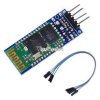Hi All,
Im just starting on a project that requires a few parameters to be sent to a PIC18F4550 via USB from an Android running V4.1. There are 2 ways to do this.
1. Use a USB to serial converter and connect to the UART of the PIC.
2. Use a direct USB interface between PIC and Droid.
I have interfaced with a PC usingVB in the past using method 2 and all is well, no rocket science involved. But this time i want to use a Droid.
My question is has anyone got any pointers to either approach?
Regards
Ray
Im just starting on a project that requires a few parameters to be sent to a PIC18F4550 via USB from an Android running V4.1. There are 2 ways to do this.
1. Use a USB to serial converter and connect to the UART of the PIC.
2. Use a direct USB interface between PIC and Droid.
I have interfaced with a PC usingVB in the past using method 2 and all is well, no rocket science involved. But this time i want to use a Droid.
My question is has anyone got any pointers to either approach?
Regards
Ray


